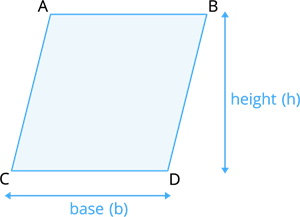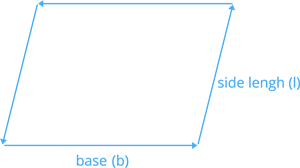UPSKILL MATH PLUS
Learn Mathematics through our AI based learning portal with the support of our Academic Experts!
Learn more
Area:
To calculate the area of a parallelogram, we multiply the base(b) times the height(h).
Area of parallelogram A = b × h square units.
For example, A parallelogram has a base of 6 m and height of 3 m. Find its Area?
base (b)=6\ m and height (h) = 3\ m.
Area
Base:
To calculate the base of the parallelogram, we divide area A by height h.
Base of parallelogram (b) = A/h unit.
For example, A parallelogram has an area of 64 m², and is 4 m height, what is its base?
Area (A)=64\ m^2 and height (h)=4\ m.
Base
Height:
To calculate the height of the parallelogram, we divide the area A by base b.
Height of parallelogram (h) = A/b unit.
For example, A parallelogram has an area of 64 m² and base is 16 m. Find its height?
Area (A)=64\ m^2 and base (b)=16\ m
Height

Perimeter:
To calculate the perimeter of a parallelogram, we multiply 2 times the (base + side length).
Perimeter of parallelogram (P) = 2 (b + l).
Where b is denoted as base and l is denoted as side length.
For example, A parallelogram has a base of 5 m and length of 3 m. Find its perimeter?
Base (b)=5\ m and side length (l)=3\ m.
Perimeter